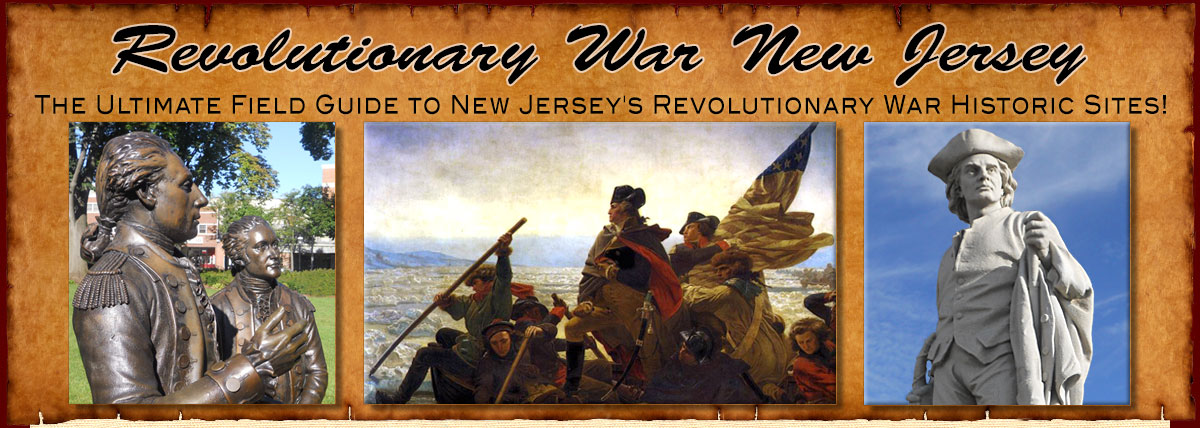

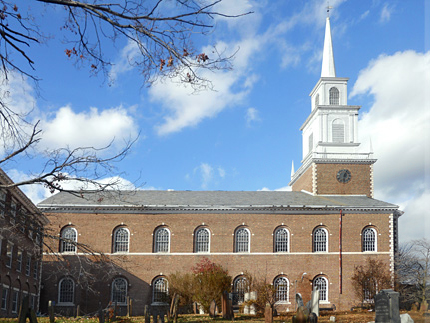
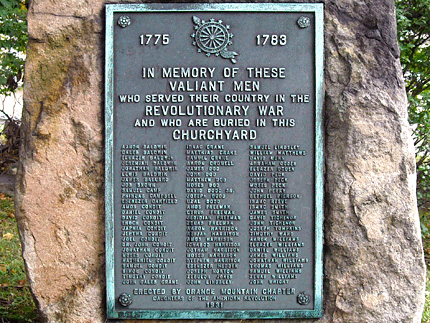
First Presbyterian Church in Orange
Main St. and Scotland Rd.
Map / Directions to the First Presbyterian Church
Map Direction to all Orange Revolutionary War Sites
The First Presbyterian Church in Orange building which stands here today is not the original structure. Three earlier ones stood two-tenths of a mile from here at the corner of Main Street and Day Street. The first was built about 1719. The second, built in 1754, was here at the time of the Revolutionary War, when the minister was Reverend Jedediah Chapman. Chapman was outspoken in support of the cause of independence, and he served as an army chaplain, which gained him the enmity of the British, who made attempts to capture him. The church building that stood at the time of the Revolution was replaced by a new building in 1813, which itself was destroyed by fire in 1927. The current church building was built in 1927/1928. [1] The church held its last service on July 18, 2010, and is no longer active. [2]
The cemetery, known as the Old Burying Ground, has burials dating back to 1723.[3] British soldiers encamped in this burial ground in 1777. [4] A boulder in the cemetery pays tribute to 78 "valiant men who served their country in the Revolutionary War and who are buried in this churchyard" and lists their names: [5]
Aaron Baldwin
Caleb Baldwin
Eleazer Baldwin
Jeremiah Baldwin
Jonathan Baldwin
Lewis Baldwin
James Ballard
Joe Brown
Samuel Camp
Phineas Campbell
Ebenezer Canfield
Amos Condit
Daniel Condit
David Condit
Enoch Condit
Japhia Condit
Jeptha Condit
Joel Condit
Dr. John Condit
Jonathan Condit
Moses Condit
Nathaniel Condit
Samuel Condit
Simon Condit
Timothy Condit
John Caleb Crane
Isaac Crane
Matthias Crane
Samuel Crane
Aaron Crowell
James Dod
John Dod
Mathew Dod
Moses Dod
David Dodd Sr.
Joseph Dodd
Uzal Dodd
Amos Freeman
Cyrus Freeman
Jedidiah Freeman
Zenas Freeman
Aaron Harrison
Abijah Harrison
Amos Harrison
Ichabod Harrison
Jotham Harrison
Moses Harrison
Stephen Harrison
Ebenezer Hedden
Joseph Horton
Zebulon Jones
John Lindsley
Samuel Lindsley
William Matthews
David Munn
Abraham Ogden
Eleazer Ogden
David Peck
Joseph Peck
Moses Peck
John Perry
Behuel Pierson
Isaac Reeve
Isaac Smith
James Smith
David Tichenor
John Tichenor
Joseph Tompkins
Timothy Ward
Aaron Williams
Eleazer Williams
Daniel Williams
James Williams
Jonathan Williams
Thomas Williams
Samuel Williams
Zenas Williams
John Wright
In addition to the soldiers listed above, there are two notable local women of the Revolutionary War era buried in this cemetery, Mary Pierson Williams and Jemima Condict.

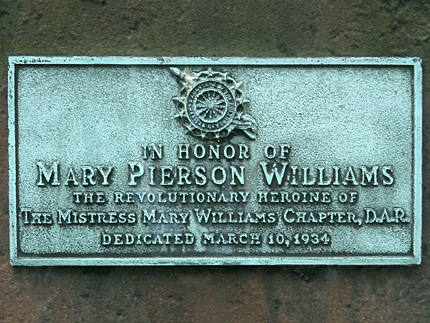
Mary Pierson Williams
(1736 -July 3, 1816, aged 79)
Mary Pierson Williams lived with her family on a farm about two miles from here, in what is now West Orange. Mary's husband and two of her sons sided with the British in the Revolutionary War, while she supported the cause of Independence. When her husband and sons left for British-held New York City in 1777, she remained behind on the family farm.
Details of the story of Mary and her family can be found on the West Orange page of this website. [6]

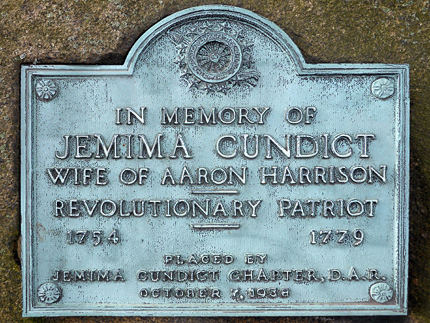
Jemima Condict
(August 24, 1754 - Nov. 14, 1779)
Jemima Condict (sometimes spelled "Cundict) kept a diary of her experiences during the Revolutionary War, that was published a century and a half later in 1930. Her diary entries give a view into the experiences of the locals during this time, as seen in the following excerpt where Jemima reacts to the news of the Battles of Lexington and Concord, the first battles of the Revolutionary War, in Massachusetts.
(Spelling, capitalization and punctuation have been left uncorrected. Regulars refers to British soldiers.)
"April 23. 1775. as every Day Brings New Troubels So this Day Brings News that yesterday very early in the morning They Began to fight at Boston. The regulers. We hear Shot first there; they killd 30 of our men A hundred & 50 of the Regulors." [7]
This entry is dated April 23, 1775. Although Mary wrote here that the fighting took place the day before, it actually took place four days before on April 19. Given the state of roads and transportation at the time, it would have taken several days for the news to reach New Jersey from Boston.

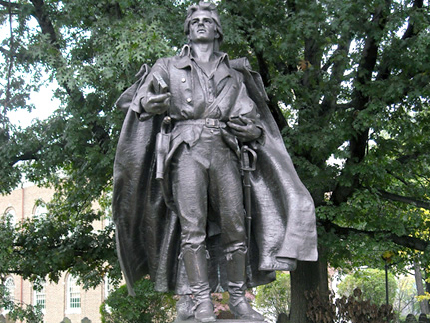
Dispatch Rider of the American Revolution
A striking statue, "Dispatch Rider of the American Revolution," stands in the corner of the cemetery looking out to the intersection of Main Street and Scotland Road. Dispatch riders served the important role of delivering messages during the war.
The statue was sculpted by Frank Edwin Elwell. It was unveiled at the Orange Centennial Ceremony on June 14, 1907. [8]

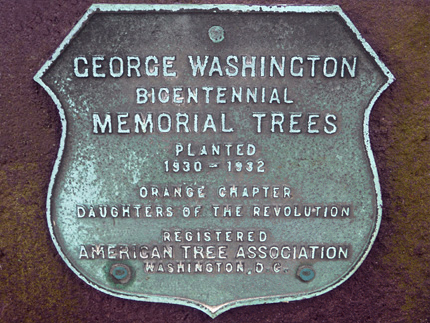
George Washington Bicentennial Memorial Trees
Millions of trees were planted throughout the United States in honor or the 200th anniversary of George Washington's birth in 1932.
A marker in the northwest corner of the cemetery notes that George Washington Memorial Trees were planted here by the Orange Chapter of the Daughters of the American Revolution. [9]

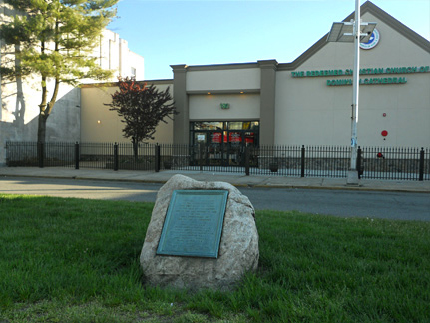
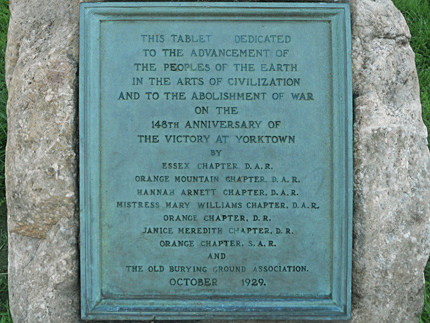
Victory at Yorktown Monument
Orange Township Military Commons
Main St. and South Main St.
Map / Directions to the Victory at Yorktown Monument
Map Direction to all Orange Revolutionary War Sites
On October 19, 1781, British General Cornwallis surrendered at the last major battle of the Revolutionary War, the Battle of Yorktown. This boulder monument was dedicated in 1929 on the 148th anniversary of that victory. It was placed by several local historic organizations. The plaque reads, "This tablet is dedicated to the advancement of the peoples of the earth in the arts of civilization, and to the abolishment of war on the 148th anniversary of the Victory at Yorktown." [10]

1. ^ Information in this paragraph about the history of the church buildings and about Reverend Jedediah Chapman was drawn from the following four sources. The pertinent information was in general agreement throughout these four sources, but each supplied different information, with some overlap.
• James Hoyt, "The Mountain Society" A History of the First Presbyterian Church of Orange, N.J. (New York: C.M. Saxton, Barker & Co, 1860) Available to be read at the Internet Archive here
▸ Pages 46 -52 describe the creation of the first building. Hoyt explains there is uncertainty about the exact time, but he concludes the first building was constructed in 1719.
▸ Page 96 describes the creation of the second building in 1754.
▸ Page 177 describes the creation of the third building in 1813.
▸ When Hoyt (who was then pastor of the church) wrote this book, the third building still existed, so there is no mention of the fourth and current building.
▸ Pages 121-122 describe Reverend Chapman's commitment to the cause of Independence, stating, "In the revolutionary struggle, Mr. Chapman espoused warmly the American cause" and mentions British attempts to capture him.• A plaque on the side of the church has an inscription that contains the following text:
"The First, Second and Third Meeting Houses of Orange, erected 1719, 1754 and 1813 stood at Main and Day streets. These buildings erected 1927-28, the third edifice having been destroyed by fire, April 5, 1927."
▸ The first three years agree with Hoyt's work, except that 1719 is given as a specific year.
▸ The date of the fire and the building of the fourth church are not mentioned in Hoyt's book because these event had not happened yet when he wrote.
• David Lawrence Pierson, History of the Oranges to 1921: Reviewing the Rise, Development and Progress of an Influential Community, Volume 1 (New York: Lewis Historical Publishing Company, 1922) p. 135 -136
Describes accounts of Chapman and the British.
States that "Rev. Jedediah Chapman divided his time between the army and his parish."
Available to be read at Google Books here
• Daughters of the American Revolution list Chapman as having served as a chaplain to Colonel Ephraim Martin's troops. See the Daughters of the American Revolution Genealogical Research System, where Chapman is Ancestor # A020899
2. ^ Aliza Appelbaum of The Star-Ledger, "Historic Orange Church to Close Today", Posted on NJ.com July 18, 2010.
3. ^ David Lawrence Pierson, History of the Oranges to 1921: Reviewing the Rise, Development and Progress of an Influential Community, Volume 1 (New York: Lewis Historical Publishing Company, 1922) p. 46 Available to be read at Google Books here
Pierson states that the oldest stone was for Anthony Olive. He quotes the text of the stone as, "Here Lies the Body of Anthony Olive Who departed this life March the 16th in the Year 1723, dec.d 87 Yeare [sic]," so the original stone was presumably intact and fully legible when he wrote the book, but it is no longer.
The original stone was replaced in 1969 with a stone that reads, "Here lies the body of Anthony Olive who departed this life March the 16th in the year 1723 aged 87 years." A smaller stone next to it says that the original was replaced in 1969 by the 250th Anniversary Committee.
4. ^ • The inscription on the plaque on the side of the church mentioned in Source Note 1 also includes the following text: "British Forces encamped here in 1777."
• James Hoyt, "The Mountain Society" A History of the First Presbyterian Church of Orange, N.J. (New York: C.M. Saxton, Barker & Co, 1860) p. 124
"The British force then encamped in the old burying-ground."
Available to be read at the Internet Archive here.
5. ^ "Valiant men..." quote and the list of names is taken from the boulder plaque in the cemetery.
The plaque states that is was "Erected by Orange Mountain Chapter, Daughters of the American Revolution, 1931."6. ^ Mary Pierson Williams' death date and age from her tombstone.
For more information about her and the Williams family, along with accompanying source notes, see the West Orange page of this website.7. ^ Jemima Condict, Jemima Condict, Her Book: Being a Transcript of the Diary of an Essex County Maid During the Revolutionary War (Newark, N.J., The Carteret Book Club, 1930) Pages 51-52
Some of Jemima's other reactions to Revolutionary War era events include the following entries, which appear on pages 36-37 and 52 respectively. Spelling, capitalization and punctuation have been left uncorrected.
"Saturday October first 1774. It seams we have troublesome times a Coming for there is great Disturbance a Broad in the earth & they say it is tea that caused it. So then if they will Quarel about such a trifling thing as that What must we expect But war & I think or at least fear it will be so"
[The Boston Tea Party occurred on December 16, 1773, almost ten months before this entry. So Jemima must be reacting here to growing tensions and events after the Boston Tea Party, rather than the event itself.]"Monday Wich was Called Training Day I Rode with my Dear father Down to see them train there Being Several Companys met togehter. I thought It Would Be a mournful Sight to see if they had been fighting in earnest & how soon they will be Calld forth to the feild of war we Cannot tell for by what What we Can hear the Quarels are not likely to be made up Without bloodshed. I have just Now heard Say that All hopes of Conciliation Between Briten & her Colonies are at an end for Both the king & his Parliment have announced our Destrucktion: fleet and armies are Prepareing with utmost diligence for that Purpose.”
[This entry, which is marked simply "Monday," was most likely made on April 3, 10, or 17, 1775.]In addition to her reaction to news about the war, Jemima's diary entries also record details of her daily life, her thoughts on marriage, and the deaths of many of her neighbors to disease. Jemima attended the First Presbyterian Church in Orange, and she also mentions sermons preached by Reverend Jedediah Chapman at the church.
8. ^ • Orange Centennial Association, 1807 - 1907, Souvenir History of the Oranges, N.J. and Program Exercises of the Centennial Celebration, June 9, 10, 11, 12, 13, 14, and 15, 1907 (Orange, NJ: Press of the Orange Journal, 1907) p. 35 - 49
Available to be read at Google Books here
▸ This booklet provides details and photographs about the history of the Dispatch Rider statue, as well as the restoration of the cemetery. It is highly recommended to anyone looking for more information.
It is worth looking through the booklet for the 1907 ads for local businesses alone. I particularly love the ad on page 34.• Sons of the American Revolution Magazine, July 8, 1907, as reprinted in Sons of the American Revolution Magazine, Volumes 2-7 p. 12-13 Available to be read at Google Books here
▸ This short notice quotes speeches given at the unveiling which do not appear in the souvenir booklet, including a speech from the statue's sculpture, Frank Edwin Elwell.
• A plaque on the side of the statue's base reads, "This statue was dedicated Friday June 14th 1907, centennial of the first town meeting of Orange, also the 130th anniversary of the adoption of the Stars and Stripes as our national emblem. In memory of the men and women of this community who assisted in establishing American Independence."
▸ Orange was formed as a Township several months before that first town meeting. It was created from a portion of Newark, which was then much larger than it is today, by an act passed by the New Jersey Legislature on November 26, 1806. The text of the act can be read in:
Joseph Bloomfield, compiler, Laws of the State of New Jersey (Trenton: James J. Wilson, 1811) p. 173 - 174 Available to be read at Google Books here.
▸ ▸ Later adjustments to the size and boundaries of Orange and Newark, as well as their status as towns/townships/cities, were made up until the twentieth century. Details can be found in:
John F. Snyder, The Story of New Jersey's Civil Boundaries: 1606-1968 (Trenton: Bureau of Geology and Topography, 1969) p. 129 - 131 Available as a PDF on the State of New Jersey website here.9. ^ For details about the Bicentennial Tree plantings throughout the country, see:
George Washington Bicentennial Commission, Activities of the Commission and Complete-Final Report of the United States George Washington Bicentennial Commission, Volume V (Washington, D.C.: George Washington Bicentennial Commission, 1932) "The Planting of Memorial Trees" chapter, pages 205-213
Available to be read at the Internet Archive here
10. ^ The plaque states that is was placed by the following organizations:
• Essex Chapter, D.A.R.
• Orange Mountain Chapter, D.A.R.
• Hannah Arnett Chapter, D.A.R.
• Mistress Mary Williams Chapter, D.A.R.
• Orange Chapter D.R.
• Janice Meredith Chapter D.R.
• Orange Chapter, S.A.R.
• The Old Burying Ground Association
The plaque states that it was placed in October 1929, which was the 148th anniversary of the Battle of Yorktown.
There appears to have been a date listed, but the number is no longer readable. If it was placed on the exact anniversary of the surrender, it would have been on the 19th, but that may not have been the case.
I would like to thank Krista White, the Digital Humanities Librarian of the John Cotton Dana Library at Rutgers University - The State University of New Jersey. She took the time to locate, scan, and send me some documents which were used in my research for this page.